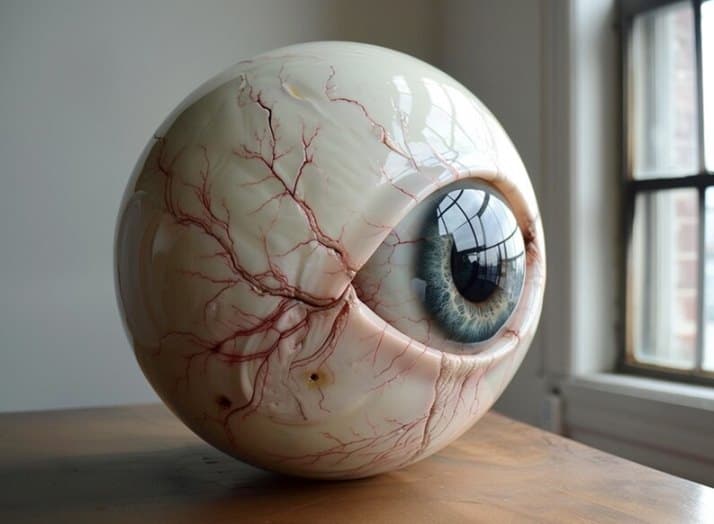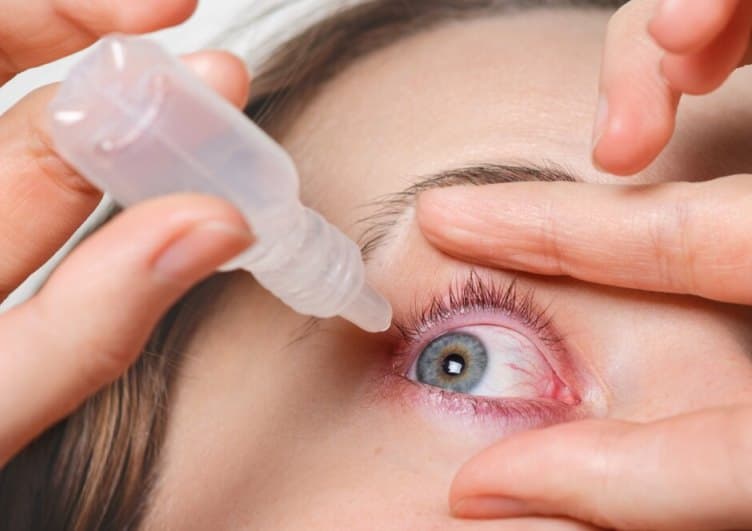Veins in the Eyes After Crying: Causes and Remedies
Tears serve as an emotional release, but they also have physical effects. Crying increases blood flow to the eyes, causing veins to become more prominent. This reaction can make your eyes appear red and irritated. Stress and emotional distress can exacerbate this condition.
It helps ease fears to know why this occurs. Proper eye care and hydration can minimize the appearance of these veins. Simple remedies like cool compresses can reduce redness. Maintaining overall eye health is crucial for preventing such issues.
Table of Contents
Causes Of Veins in Eyes
Many people notice veins in their eyes after crying. This is a common occurrence. Understanding the reasons can help manage and prevent it.
Emotional Response
Crying is often an emotional response. When you cry, your body releases stress hormones. These hormones can cause your blood vessels to dilate. This dilation makes veins in your eyes more visible.
Tears produced during crying also contribute. Tears are salty and can irritate your eyes. This irritation can lead to redness and more prominent veins.
Physical Strain
Crying involves a lot of physical strain. Your face muscles contract and your eyes produce more tears. Both these actions can increase blood flow to your eyes. Increased blood flow can make veins more noticeable.
Excessive rubbing of your eyes while crying can also cause veins to appear. Rubbing can irritate the delicate tissues around your eyes. This irritation can lead to visible veins and redness.
Preventive Measures to avoid visible veins after crying can include:
- Gently patting your eyes with a soft cloth
- Using a cold compress to reduce swelling
- Avoiding rubbing your eyes
Role Of Tears
Tears play a crucial role in eye health. They provide lubrication and help flush out irritants. But too many tears can cause visible veins in your eyes.
Lubrication
Tears keep your eyes moist. They create a thin layer on the eye’s surface. This layer protects your eyes from dryness. Dry eyes can cause discomfort and redness. Tears help you see clearly by providing this moisture.
Irritation
Crying can irritate your eyes. Tears carry salt, which can irritate the delicate eye tissues. This irritation can make veins more visible. Irritation also causes blood vessels to expand. Expanded blood vessels are more noticeable.
Blood Vessel Dilation
Crying can lead to visible veins in your eyes. This phenomenon is primarily due to blood vessel dilation. Understanding this process is crucial to knowing why your eyes appear red and veiny.
Increased Blood Flow
Crying increases blood flow to your eyes. This is a natural response to emotional stress. When you cry, your body sends more blood to your eyes. The extra blood makes the veins more visible.
Blood vessels expand to accommodate this increased flow. This expansion is what causes the redness and visible veins. The eyes try to cope with the extra fluid and blood.
Inflammatory Response
Crying triggers an inflammatory response in your eyes. This is your body’s way of protecting itself. Tears contain enzymes and proteins that can irritate the eye surface.
These irritants cause the blood vessels to dilate. Swelling and redness are common during this process. The inflammation makes the veins in your eyes more noticeable.
Eye Anatomy
The human eye is a complex organ with many intricate parts. Its anatomy can be understood in order to explain why veins form after sobbing. Let’s explore the key components that contribute to this phenomenon.
Surface Vessels
The eye’s surface is covered by a clear layer called the conjunctiva. This layer contains tiny blood vessels, known as surface vessels. These vessels are usually not visible. They can become more noticeable after crying.
Crying causes increased blood flow to the eye’s surface. Tears contain substances that can irritate the conjunctiva. This irritation makes the surface vessels swell, causing them to appear red.
Deeper Vessels
Beneath the conjunctiva lies the sclera, the white part of the eye. The sclera also has blood vessels called deeper vessels. These vessels are larger than surface vessels.
When you cry, the pressure within the eye changes. This change in pressure can make deeper vessels expand. The expansion makes them more visible through the sclera, adding to the redness.
Understanding these vessel types helps explain the redness in your eyes. Crying affects both surface and deeper vessels, making them more prominent.
Stress And Crying
Crying can be a cathartic experience, releasing pent-up emotions. But, have you ever noticed veins in your eyes after crying? This phenomenon often ties back to stress. Stress and crying have a close relationship, affecting your body in various ways, particularly your eyes.
Hormonal Impact
Stress triggers the release of stress hormones like cortisol. These hormones can cause blood vessels to dilate. During crying, this dilation can make veins in your eyes more visible. Tears also contain stress hormones, helping you feel better but also affecting your eyes.
Nervous System
Your nervous system reacts strongly to stress. Crying activates the parasympathetic nervous system. This system helps your body calm down after stress.
It causes blood vessels to expand, making veins in your eyes appear more prominent. The autonomic nervous system also controls tear production, linking stress, crying, and visible veins in your eyes.
Check Also: Chalazion in the eye: Causes, Cures and Treatments
Temporary Vs. Persistent Redness
Crying can sometimes leave you with red veins in your eyes. The difference between temporary and persistent redness can be essential for eye health. Let’s explore how crying impacts your eyes in the short and long term.
Short-term Effects
After crying, you might notice red veins in your eyes. This happens due to increased blood flow. Tears contain substances that can irritate your eyes. The irritation causes your blood vessels to expand.
Redness from crying usually goes away on its own. It’s a temporary condition. Your eyes will return to their normal state once the irritation subsides.
Long-term Concerns
Persistent redness can be a sign of underlying issues. If red veins in your eyes last longer, it could indicate a serious problem. Conditions like chronic dry eyes or allergies might be to blame.
Soothing Red Eyes
After crying, you might notice veins in your eyes. This can be uncomfortable. Taking steps to soothe red eyes can help you feel better. Below are two effective methods: using a cold compress and eye drops.
Cold Compress
A cold compress can reduce redness and swelling. Here’s how to use it:
- Take a clean cloth.
- Soak it in cold water.
- Wring out excess water.
- Place the cloth over your closed eyes.
- Leave it on for 10 minutes.
This simple method can provide quick relief. The cold temperature helps constrict blood vessels. This reduces redness and makes your eyes feel better.
Eye Drops
Eye drops are another effective way to soothe red eyes. They work by moisturizing and reducing inflammation. Follow these steps to use eye drops:
- Wash your hands thoroughly
- Shake the eye drop bottle if instructed
- Tilt your head back slightly. You can sit down and look up or lie down on a flat surface.
- Using your non-dominant hand, gently pull down the lower eyelid to create a small pocket.
- Hold the dropper above your eye, ensuring it doesn’t touch your eye or eyelashes.
- Close your eye gently for a minute or two to allow the drops to spread evenly.
- Avoid blinking or rubbing your eye immediately after administering the drops.
When To Seek Help
Crying can cause veins in your eyes to become visible. This is usually not a cause for concern. But there are times when you should seek medical help.
Persistent Symptoms
If you notice that the veins in your eyes do not go away after crying, it may be time to seek help. Persistent symptoms could indicate a more serious issue.
Here are some signs to watch for:
- Redness that lasts for more than a few days.
- Swelling or pain in the eyes.
- Changes in vision or blurry vision.
Underlying Conditions
Veins in the eyes can sometimes be a sign of underlying health conditions. These can range from mild to severe. Knowing these conditions can help you take action early.
Some possible underlying conditions include:
| Condition | Symptoms |
|---|---|
| Conjunctivitis | Red, itchy eyes with discharge. |
| Dry Eye Syndrome | Eyes feel dry, gritty, or burning. |
| Uveitis | Pain, redness, and blurred vision. |
| Allergies | Red, watery eyes with itching. |
If you have any of these symptoms, visit a healthcare professional. They can give you the best advice and treatment.
Conclusion
Veins in the eyes becoming visible after crying is a natural response to emotional stress and tears. Understanding the physiological processes behind this can help manage discomfort and reassure individuals that it’s a temporary condition. By taking simple steps like rest, hydration, and gentle eye care, one can often alleviate symptoms and promote eye health after crying.
Knowing how our bodies react to stress on an emotional and physical level can help us take better care of ourselves and ensure our mental and physical health.

